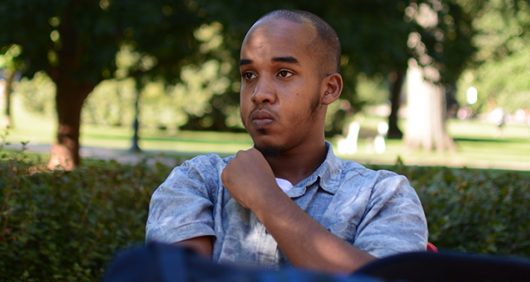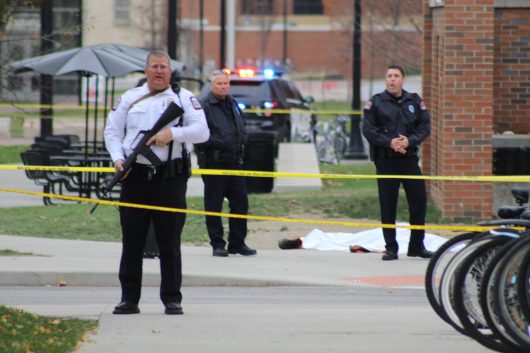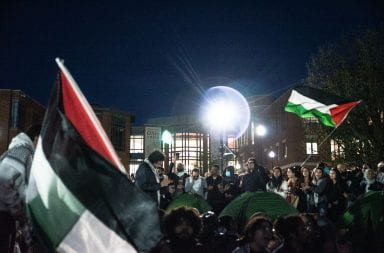
Vehicles from the Columbus Division of Fire and the Columbus Division of Police line West 19th Avenue on Nov. 28. Credit: Mason Swires | Assistant Photo Editor
Although news media and politicians have mentioned terrorism, as of Wednesday, authorities had not released a motive in the Monday attack on Ohio State’s campus. During a news conference on Wednesday, an FBI agent told members of the media that the attacker might have been inspired by terrorists, but it was “too soon” to call anything an act of terror.
“It’s too soon to draw any conclusions if this is terrorism,” FBI special agent Angela Byers said at a news conference held with the Columbus Division of Police on Wednesday afternoon. Byers said the attacker, Abdul Razak Ali Artan, might have been inspired by Anwar al-Awlaki, the now-deceased al Qaeda-linked terrorist, as well as Islamic State.
Artan, a third-year in logistics management, drove a gray Honda Civic sedan into a crowd of people gathered outside of Watts Hall for after a fire alarm went off. Artan then leaped out of the vehicle and reportedly began to attack the crowd with a butcher knife. He was then shot and killed by a University Police officer Alan Horujko. Horujko is now on administrative leave, which officials have said is standard procedure following an officer-involved shooting that results in a death. Officials said the shooting will be presented, to a grand jury, as is also standard procedure.
Authorities have said details, such as why Artan committed the attack, targeted OSU, or targeted the area outside Watts Hall remain unknown.
It was confirmed Wednesday that a bystander was shot in the ankle. Authorities told reporters they suspect the bullet came from Horujko’s gun, as there has been no evidence found of another firearm. The FBI’s Joint Terrorism Task Force, which includes the Columbus Division of Police and University Police, currently believe Artan acted alone.
“We’re looking at the Facebook post and trying to determine the authentication.” — Angela Byers, FBI agent
Shortly after Artan attacked campus, two people were handcuffed in the Lane Avenue parking garage before police cleared the area and determined that Artan acted alone. Authorities continued searching the area after OSU lifted the shelter-in-place order, but some buildings remained locked down and some areas remained closed off even after the order was lifted.
NBC reported that Artan, who was Muslim, went on a rant about the treatment of Muslims in America on a Facebook page that is believed to belong to him. Todd Lingren, an FBI spokesman, said the page has not been officially released to any media outlets and that its authenticity has not yet been confirmed.

The initial photo of Abdul Razak Ali Artan that appeared in an August issue of The Lantern. Credit: Kevin Stankiewicz | Oller Reporter
“(The Facebook page) is certainly something that is being investigated,” Lingren said in an email.
Byers also said the page had not been authenticated.
“We believe he may have been inspired by Anwar al-Awlaki, or ISIS … our investigation will determine that,” Byers said. “We’re looking at the Facebook post and trying to determine the authentication, so that is one thing that leads us to believe that it’s possible he may have been inspired by Anwar al-Awlaki.”
In August, by chance, Artan was the subject of The Lantern’s weekly feature “Humans of Ohio State.” He expressed anxiety about praying in public and being judged by society and the media based on stereotypes surrounding his faith.
Wednesday morning, President-elect Donald Trump — who ran a hard-line campaign critical of both Islam and immigration — tweeted that Artan, who was a Somali refugee, should have never been allowed in the country.
“ISIS is taking credit for the terrible stabbing attack at Ohio State University by a Somali refugee who should not have been in our country,” Trump tweeted.
Media representatives for the president-elect did not return a request for comment regarding why Trump believes Artan should not been allowed to enter the U.S.
As defined by the United Nations, a refugee is someone who has been forced to flee his or her country because of persecution, war or violence. After civil war broke out in Syria, fears have grown in the U.S. that refugees with terror ties have made it into the United States, despite background checks.
Islamic State has claimed the attack, although that doesn’t necessarily mean that Artan had any communication or connection to the terrorist group. The group has often claimed attacks after they’ve happened, based on people who acted alone or in the name of Islamic State.
The terrorist organization declared Artan was a “soldier of the Islamic State,” according to its newswire, Amaq.

Police officers stand near the body of Abdul Razak Ali Artan, lying near the Chemical and Biomolecular Engineering Chemistry building on North Campus on Nov. 28. Credit: Mason Swires | Assistant Photo Editor
Dakota Rudesill, a professor at the Moritz College of Law and a counter-terrorism expert, said that although recent evidence points to a possible link between Artan and ISIS, one should still not assume to know the entire story.
“There are several data points we have now to suggest that the individual was self-radicalized and reached out (to ISIS) … but we do not want to jump to conclusions,” Rudesill said.
William Clark, a professor emeritus of material science engineering who was a victim of the attack, said at a press conference Tuesday that he witholding his judgement of Artan.
“Before I pass judgment on this young man, I’d like to see what exactly the circumstances are and exactly why he took the course of action he chose,” Clark said. “At the end of the day, as I said earlier, I’m still going home this afternoon and he’s dead.”
Sheridan Hendrix contributed to this article.


